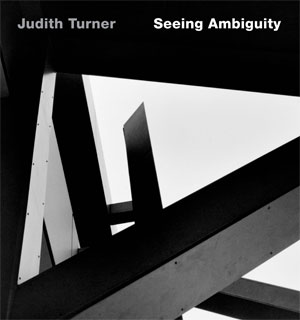This exquisite oversized book of Turner’s abstract black-and-white photographs spans 35 years (1974-2009), demonstrating how she has been able to expand a language developed for crisp geometric structures to a variety of modern buildings and enabling the reader to see them anew.

Turner first became known for the book Judith Turner Photographs Five Architects (Rizzoli, 1980), which depicted the “white architecture” of the 1970s of Peter Eisenman, John Hejduk, Michael Graves, Richard Meier, and Charles Gwathmey. Her photographs, like the buildings of those architects at that time, were solidly sculptural and more complicated than they first appeared. Soon, Turner expanded her repertoire by photographing James Ingo Freed’s Jacob K. Javits Convention Center while it was under construction from 1981 to 1983. These pictures retained the elegance and unusual points of view of the earlier ones but incorporated some of the rawness of the building process, such as exposed rebar, the way an artist might in a sketch. But these were not sketches. They were very carefully composed, tightly cropped studies in light and shadow, from unusual angles. They resembled, conceptually, pioneering sculpture of the time.
In the new book’s introductory essay, Robert Elwall, the photographs curator of the British Architectural Library at the Royal Institute of British Architects, notes that before the 1920s, architectural photography was strictly descriptive. Modernism brought the first architectural photographs that were works of art in their own right. Still, the genre remained—and remains—unusual, though there are commercial architectural photographs of real artistic quality. Turner’s are different though. Both Elwall and his co-author, Joseph Rosa, argue that her training in graphic design helped prepare her for this very different kind of communication about her chosen subject matter. Over the years, she has had numerous exhibitions and published half a dozen books of her photographs. This one was accompanied by a retrospective exhibition this summer at the University of Michigan Museum of Art, where Rosa is now director.
Turner’s photographs are not merely intriguingly beautiful works of art. They can teach a great deal about buildings, the behavior of light, point of view, and the ambiguity of perception. They allow those of us who think we know our way around buildings to see them in ways we would never have imagined. Some of Turner’s images, shot from under staircases, interstitial spaces, and rooftops are revelatory. Her understanding of the architectural artifact is extraordinary and her takes on Erich Mendelsohn, Le Corbusier, Frank Lloyd Wright, Alvar Aalto, Louis Kahn, Tadao Ando, Norman Foster, Frank Gehry, Fumihiko Maki, Renzo Piano, Zaha Hadid, Shigheru Ban and other architects are absolutely unique.



Post a comment to this article
Report Abusive Comment